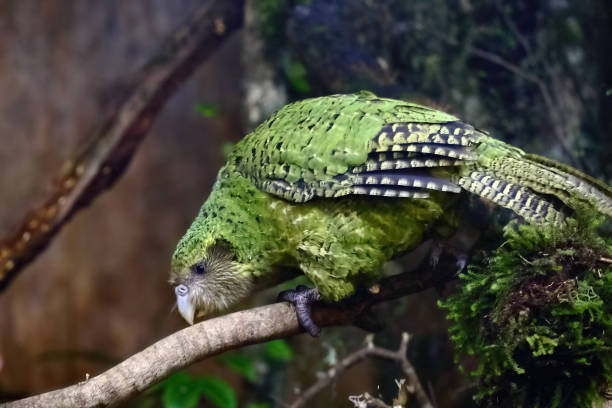Kākāpō: Guardians of New Zealand's Ancient Forests
The enigmatic kākāpō, a nocturnal parrot native to New Zealand, stands as a testament to nature's resilience and the power of conservation. These flightless, moss-green birds have captured the hearts of researchers and nature enthusiasts worldwide, sparking a global effort to save them from the brink of extinction. This article delves into the fascinating world of the kākāpō, exploring their unique characteristics, the challenges they face, and the innovative conservation strategies employed to ensure their survival.

Kākāpō are the world’s only flightless parrots, with vestigial wings that serve more as balancing aids than instruments of flight. Their bodies are stout and round, covered in soft, moss-green feathers that provide excellent camouflage in their forest habitat. Adult kākāpō can weigh up to 4 kilograms, making them the heaviest parrots in the world.
Nocturnal Nature and Peculiar Behaviors
Unlike most parrots, kākāpō are strictly nocturnal, emerging from their daytime hideouts only after sunset. This adaptation allowed them to avoid diurnal predators in their ancestral environment. Their large, owl-like eyes are well-suited for low-light conditions, enabling them to navigate the forest floor with ease.
One of the most fascinating aspects of kākāpō behavior is their unique breeding system. Males engage in an elaborate courtship ritual known as lek breeding. During the breeding season, which occurs every 2-4 years when rimu trees produce abundant fruit, male kākāpō gather in clearings to compete for female attention. They create shallow bowls in the ground and emit deep, resonant booming calls that can travel for kilometers through the forest.
The Brink of Extinction: Threats and Challenges
The arrival of humans and introduced predators in New Zealand spelled disaster for the kākāpō population. By the 1970s, the species was thought to be extinct on the mainland, with only a small population remaining on Stewart Island. The introduction of cats and stoats to this last refuge further decimated their numbers.
In 1977, a glimmer of hope emerged with the discovery of a small population on Stewart Island. This finding sparked an intensive conservation effort that continues to this day. However, the challenges facing kākāpō recovery are numerous and complex.
Low genetic diversity, infrequent breeding cycles, and vulnerability to introduced predators all pose significant threats to the species’ survival. Additionally, the kākāpō’s low reproductive rate – females typically lay only 1-4 eggs per breeding season – makes population growth a slow and precarious process.
Innovative Conservation: The Kākāpō Recovery Programme
The Kākāpō Recovery Programme, established by the New Zealand Department of Conservation, has been at the forefront of efforts to save this iconic species. The program employs a range of cutting-edge conservation techniques to protect and increase the kākāpō population.
One of the most successful strategies has been the relocation of all known kākāpō to predator-free island sanctuaries. These islands, including Codfish Island (Whenua Hou) and Anchor Island, provide safe havens where kākāpō can breed without the threat of introduced predators.
The program also utilizes advanced technology to monitor and protect individual birds. Each kākāpō is fitted with a radio transmitter, allowing researchers to track their movements and health status. This constant surveillance enables rapid intervention in case of illness or injury.
Artificial Insemination and Genetic Management
To address the issue of low genetic diversity, the Kākāpō Recovery Programme has pioneered the use of artificial insemination in parrot conservation. This technique allows researchers to manage breeding pairs strategically, maximizing genetic diversity in the small population.
The program has also developed specialized incubation and hand-rearing techniques for kākāpō chicks. When necessary, eggs are removed from nests and artificially incubated, ensuring the highest possible survival rate. Chicks are then hand-reared until they are old enough to be released back into the wild population.
A Glimmer of Hope: Recent Successes and Future Prospects
Recent years have seen some encouraging developments in kākāpō conservation. In 2019, a record-breaking breeding season saw the population increase to over 200 individuals for the first time in decades. This success was attributed to a combination of favorable environmental conditions and the tireless efforts of conservation teams.
Despite these positive developments, the future of the kākāpō remains uncertain. Climate change poses a new threat, potentially disrupting the fruiting cycles of the rimu trees upon which kākāpō breeding depends. Additionally, the limited habitat available on predator-free islands may soon reach carrying capacity, necessitating new conservation strategies.
As conservation efforts continue, researchers are exploring innovative solutions to these challenges. Proposals include the development of predator-resistant mainland sanctuaries and the potential use of genetic technologies to enhance the species’ resilience.
The story of the kākāpō serves as both a cautionary tale and a beacon of hope in wildlife conservation. It demonstrates the devastating impact of human activity on vulnerable species, while also showcasing the power of dedicated conservation efforts to bring a species back from the brink of extinction. As we look to the future, the fate of the kākāpō remains intertwined with our own, a living reminder of our responsibility to protect and preserve the natural world.




